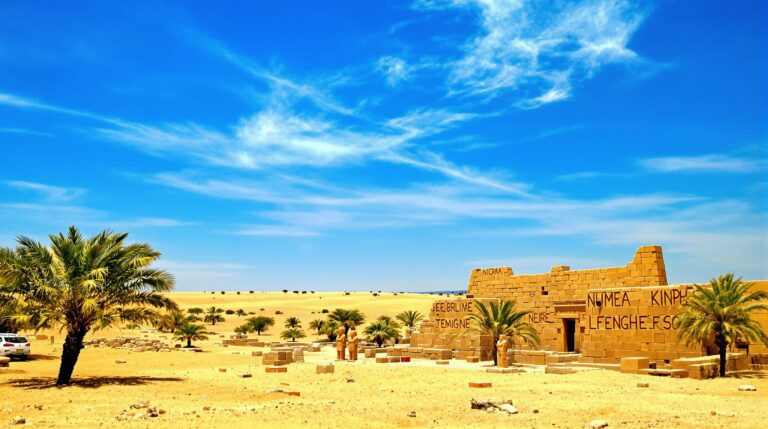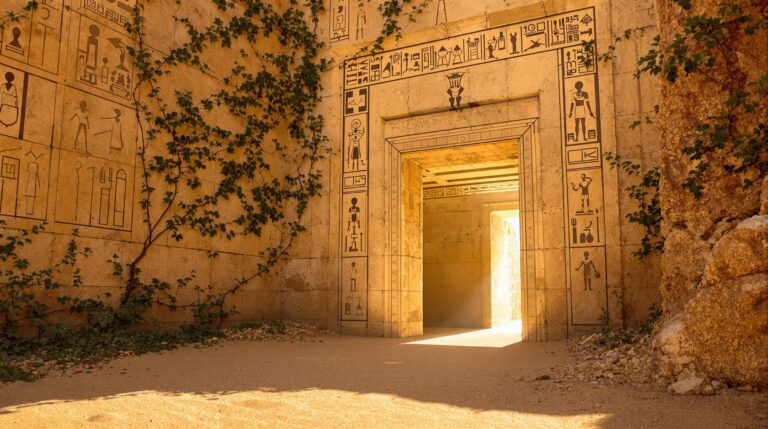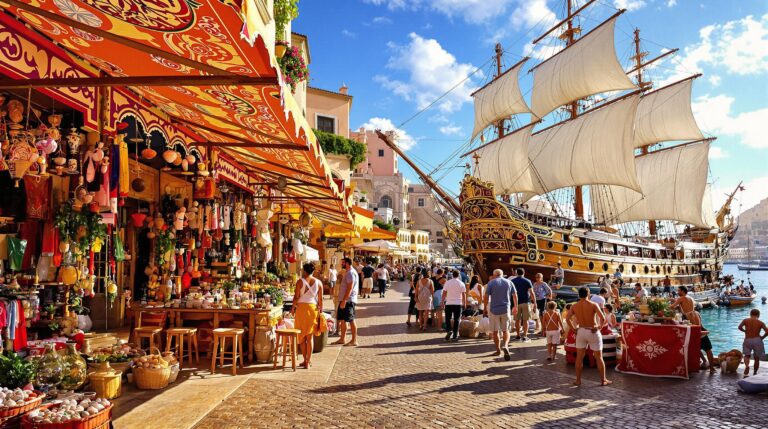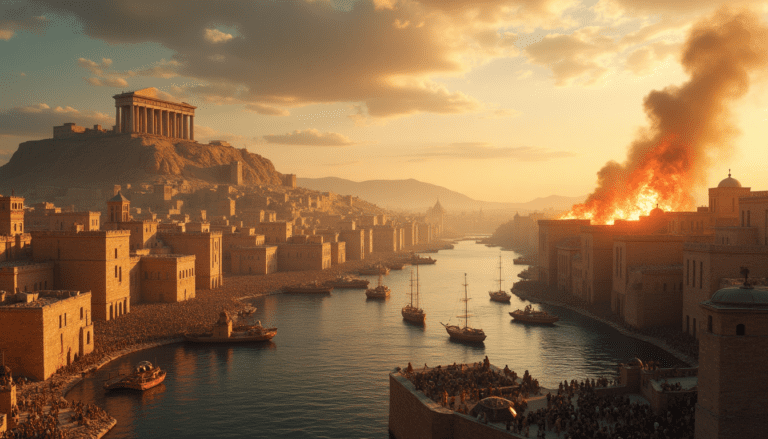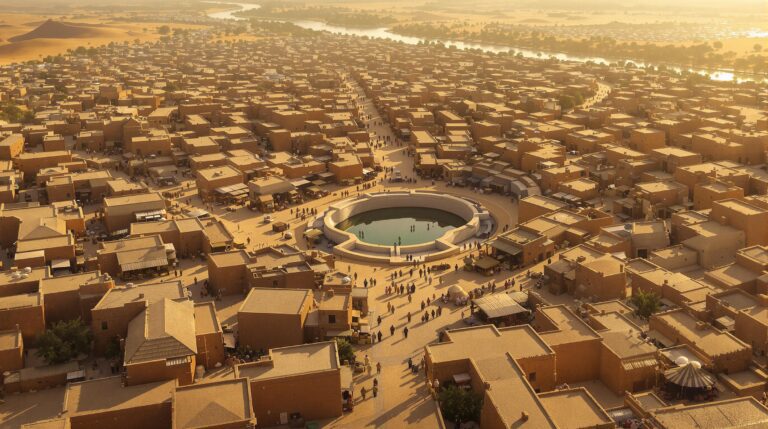The Olmecs: First Civilization of Mesoamerica

The Olmecs stand as a pivotal force in Mesoamerican history, emerging around 1200 BCE in present-day Mexico.
Their urban centers reflect a sophisticated societal structure and remarkable artistic achievements.
Yet, the true extent of their influence on subsequent civilizations raises intriguing questions.
How did their innovations in religion, art, and governance shape the cultures that followed? Exploring these aspects reveals a complex web of connections that still resonate today.
Summary of Key Points
Hide- The Olmecs emerged in fertile lowlands, establishing urban centers like San Lorenzo and La Venta that showcased advanced societal structures.
- Their complex social hierarchy centered around powerful elites, blending governance with spiritual authority and shaping daily life and culture.
- Olmec religion featured a rich cosmology with veneration of deities and sacred animals, emphasizing communal identity through rituals and ceremonies.
- Artistic achievements included colossal stone heads and jade sculptures, reflecting advanced techniques and cultural identity, alongside early proto-writing systems.
- The Olmecs influenced later Mesoamerican cultures, including the Maya and Aztecs, leaving a lasting legacy through shared traditions and practices.
Origins of The Olmecs and Early Settlements
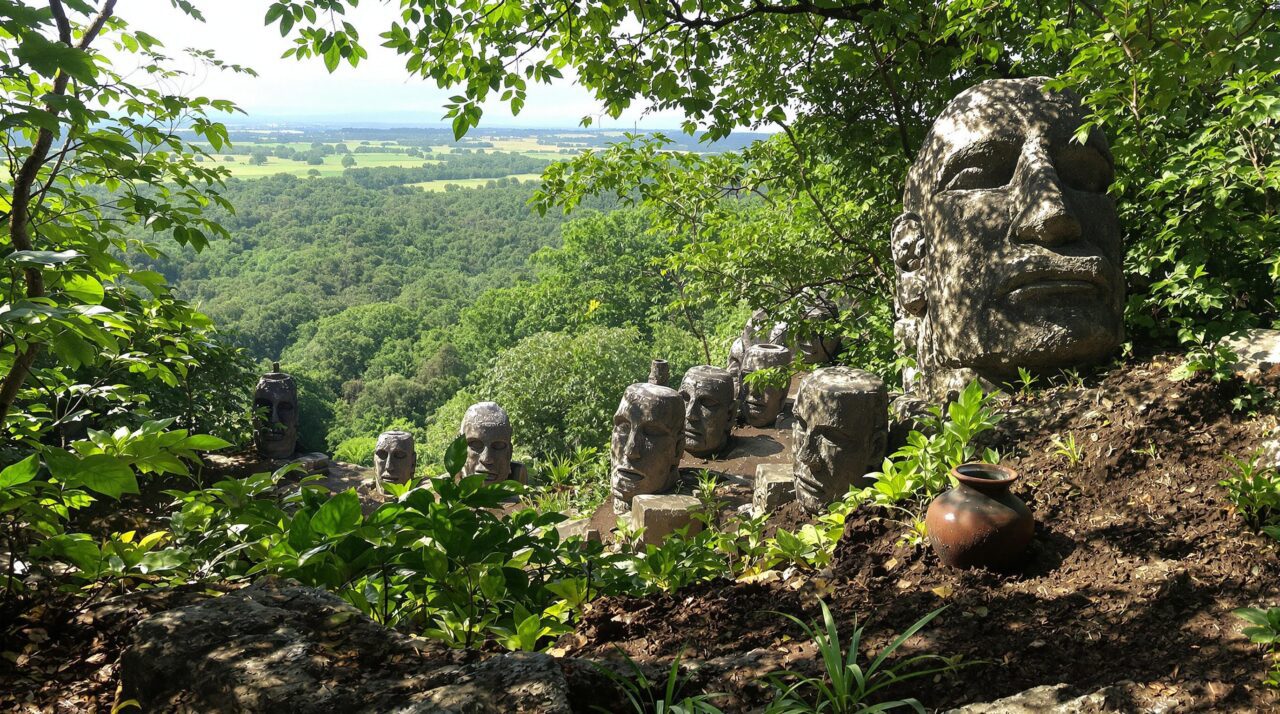
The Olmecs emerged in a region defined by its rich alluvial plains and abundant resources, which played an essential role in their development.
The establishment of significant urban centers like San Lorenzo and La Venta highlights their advanced societal structure and innovative agricultural practices.
The Geography That Shaped the Olmecs
The geography of the Olmec civilization played a pivotal role in its emergence and development.
Nestled between fertile lowlands, rivers, and dense jungles, these early settlers capitalized on abundant natural resources and strategic trade routes.
This advantageous positioning not only fostered agricultural prosperity but also facilitated cultural and economic exchanges, laying the foundation for a complex society.
Fertile Lowlands Between Rivers and Jungles
Nestled between the winding tributaries of the Coatzacoalcos and Papaloapan rivers, the fertile lowlands of Mesoamerica served as a crucible for the Olmec civilization.
This lush landscape, abundant in resources, fostered agricultural innovation and community development.
The interplay of rivers and jungles not only shaped their sustenance but also influenced their cultural identity, laying the groundwork for future Mesoamerican societies.
Strategic Trade Routes and Natural Resources
Numerous strategic trade routes emerged from the Olmec heartland, facilitating connections between diverse regions and fostering economic prosperity.
These routes enabled the exchange of essential natural resources, such as jade and obsidian, enhancing cultural and technological advancements.
The interplay of geography and trade not only shaped Olmec society but also laid the foundation for future Mesoamerican civilizations, demonstrating the importance of interconnectedness in human development.
Founding of San Lorenzo and La Venta
The founding of San Lorenzo and La Venta marks a pivotal moment in Olmec civilization, showcasing advanced monumental planning and urban layout that would influence future Mesoamerican societies.
These early settlements not only reflected sophisticated architectural design but also demonstrated agricultural innovations that led to food surpluses, fostering population growth and social complexity.
Analyzing these developments reveals how the Olmecs established a foundation for cultural and political structures that would resonate throughout the region.
Monumental Planning and Urban Layout
As urban centers began to emerge in Mesoamerica, the Olmecs demonstrated remarkable foresight in their monumental planning and urban layout, particularly in the founding of San Lorenzo and La Venta.
Their careful arrangement of structures, plazas, and ceremonial sites revealed an understanding of social organization.
This intentional design not only facilitated community interactions but also reflected the Olmecs’ cultural values and aspirations for societal cohesion.
Agricultural Innovation and Food Surplus
Innovations in agriculture played a pivotal role in the emergence of the Olmec civilization, laying the groundwork for their impressive urban centers like San Lorenzo and La Venta.
Techniques such as slash-and-burn farming and the cultivation of staple crops led to significant food surpluses. This abundance not only supported population growth but also fostered social complexity, enabling the rise of distinct cultural and political identities.
Society, Leadership, and Daily Life
The Olmec civilization, often regarded as the foundation of Mesoamerican culture, exhibited a complex social structure characterized by distinct hierarchies and political authority.
Leadership likely centered around powerful elites, whose influence shaped both governance and daily life within Olmec communities.
Understanding the interplay between social organization and everyday activities reveals the intricate dynamics that defined this early civilization.
Social Structure and Political Authority
The Olmec civilization exhibited a complex social structure characterized by elite rule, where leaders often held dual roles as political authorities and shamans, intertwining governance with spiritual oversight.
Artifacts from this society provide compelling evidence of class hierarchies, revealing the stratification that defined daily life and social interactions.
This interplay between leadership and social class not only shaped the Olmec identity but also laid the groundwork for future Mesoamerican civilizations.
Elite Rule and the Role of Shamans
Although the Olmec civilization is often celebrated for its monumental art and complex society, the intricate interplay of elite rule and the role of shamans considerably shaped its social structure and political authority.
Elite leaders, often in tandem with shamans, wielded significant influence, guiding spiritual practices and societal norms.
This duality fostered a cohesive community, intertwining governance with the metaphysical, thereby enriching Olmec identity and cultural continuity.
Evidence of Class Hierarchies in Artifacts
Artifacts from the Olmec civilization reveal striking evidence of class hierarchies that permeated their society.
Key findings include:
- Elaborate ceremonial masks, indicating elite status.
- Intricate pottery, showcasing skilled craftsmanship reserved for the affluent.
- Monumental stone heads, suggesting political authority and power.
- Simple tools and utilitarian items, reflecting the daily life of the lower classes.
These artifacts illuminate the complex social stratification within Olmec culture.
Everyday Life in Olmec Communities
Everyday life in Olmec communities was intricately woven around their tools, dwellings, and trade goods, reflecting both their ingenuity and resourcefulness.
The production of textiles and pottery not only served practical needs but also conveyed cultural identity and social status.
Subsistence practices, driven by agricultural advancements, shaped the rhythms of daily life and underscored the interconnectedness of Olmec society with its environment.
Tools, Dwellings, and Trade Goods
In the heart of Olmec society, tools, dwellings, and trade goods formed the backbone of daily life, reflecting both the ingenuity and resourcefulness of this ancient civilization.
Key elements included:
- Stone tools for agriculture and crafting
- Mud-brick dwellings providing shelter
- Intricate trade goods facilitating commerce
- Ritual items showcasing spiritual beliefs
These components underscored the complex interactions within Olmec communities, fostering both survival and cultural expression.
Textiles, Pottery, and Subsistence Practices
While exploring the daily lives of the Olmecs, it becomes evident that textiles, pottery, and subsistence practices were not merely functional elements but also profound expressions of their cultural identity.
Textiles reflected social status and artistry, while pottery showcased intricate designs and utility.
Subsistence practices, rooted in agriculture and fishing, guaranteed community survival, intertwining daily life with the rhythms of nature and cultural heritage.
Religion, Symbolism, and Ritual
The Olmec civilization‘s religious framework was intricately intertwined with their understanding of cosmology and the natural world, as evidenced by their veneration of various deities and sacred animals.
Rituals and ceremonies served as essential expressions of this belief system, often taking place at significant sacred sites that reinforced communal identity and spiritual connection.
Through offerings and symbolic acts, the Olmecs articulated their relationship with the divine, shaping a cultural narrative that would resonate throughout Mesoamerican history.
Deities, Sacred Animals, and Cosmology
The Olmec civilization’s reverence for the jaguar as a symbol of divine power underscores the intricate relationship between nature and spirituality in their cosmology.
This duality reflects a worldview where the physical and spiritual domains are intertwined, influencing their rituals and societal structure.
Through the exploration of these sacred beliefs, one gains insight into the foundational elements that shaped Olmec identity and culture.
The Jaguar as a Divine Power Symbol
Central to Olmec cosmology, the jaguar emerges as a powerful symbol of divine authority and transformation.
Its significance can be distilled into four key aspects:
- Ferocity – Representing strength and power in both nature and human endeavors.
- Mystery – Embodying the enigmatic forces of the universe.
- Transcendence – Bridging the earthly and spiritual domains.
- Fertility – Signifying life’s cyclical nature and regeneration.
Duality and the Spiritual Worldview
Duality pervades the Olmec spiritual worldview, reflecting an intricate balance between opposing forces that govern existence.
This dualism is evident in their deities and cosmology, where life and death, creation and destruction coexist harmoniously.
Sacred animals, like the jaguar, symbolize this tension, embodying both ferocity and protection.
Through rituals, the Olmecs sought to navigate these complexities, fostering a profound connection to their spiritual reality.
Ceremonies, Offerings, and Sacred Sites
The Olmec civilization’s religious practices were profoundly expressed through their ceremonies, offerings, and the construction of sacred sites, which served as focal points for community gatherings and spiritual activities.
Altars and ritual objects unearthed from burial sites reveal a complex relationship between the living and the divine, suggesting a vibrant mosaic of beliefs that influenced subsequent Mesoamerican cultures.
Altars, Burials, and Ritual Objects
While exploring the religious practices of the Olmecs, one cannot overlook the significance of altars, burials, and ritual objects, which served as focal points for their ceremonies and offerings.
Key elements include:
- Elaborate stone altars, central to rituals.
- Intricate burial sites, reflecting social hierarchy.
- Ceremonial artifacts, embodying spiritual beliefs.
- Offerings of food and valuables, symbolizing devotion.
These components reveal the profound connection between the Olmecs and their spiritual world.
Influence on Later Mesoamerican Traditions
As the foundational civilization of Mesoamerica, the Olmecs profoundly influenced subsequent cultures, shaping their religious practices, symbolism, and rituals.
Their pantheon of deities and ceremonial sites established a template for later societies. The Olmec’s use of ritual offerings and intricate iconography resonated in cultures like the Maya and Aztecs, illustrating a continuum of spiritual expression that echoed through the ages.
Achievements in Art and Architecture
The Olmecs left a profound legacy in the domain of art and architecture, marked by their monumental Colossal Stone Heads that stand as proof of their ingenuity and cultural identity.
These impressive sculptures, alongside a variety of smaller decorative works, reveal not only their technical skill but also their ability to convey complex social and religious narratives.
The Colossal Stone Heads
The colossal stone heads of the Olmec civilization stand as monumental achievements in art and architecture, showcasing not only remarkable craftsmanship but also the social and cultural identity of their creators.
Their construction involved sophisticated methods of transport and carving, raising questions about the technological capabilities of the Olmecs.
Furthermore, the meanings and representations behind these imposing sculptures invite speculation about their role in reflecting power, lineage, and the complex belief systems of early Mesoamerican society.
Methods of Transport and Carving
Transporting and carving the colossal stone heads of the Olmecs required remarkable ingenuity and determination.
This monumental task involved:
- Selecting basalt from distant quarries.
- Employing advanced tools for precision carving.
- Utilizing manpower and innovative techniques for transportation.
- Traversing challenging terrains to position the colossal creations.
These methods reflect the Olmecs’ resourcefulness and their profound commitment to artistic expression, shaping a legacy that endures today.
Meaning, Identity, and Theories of Representation
Colossal stone heads stand as monumental symbols to the Olmecs’ cultural identity, reflecting their complex understanding of representation.
These sculptures, with their distinct facial features, suggest a deep connection to leadership and lineage.
Theories surrounding their purpose range from religious significance to political power, inviting viewers to ponder the intricate relationship between art, identity, and societal values in this early Mesoamerican civilization.
Smaller Sculptures and Decorative Works
The Olmecs demonstrated remarkable artistry through their smaller sculptures, particularly in the intricate jade figures that reveal a sophisticated understanding of iconography.
These works not only showcase advanced artistic techniques but also convey complex cultural messages, reflecting the civilization’s values and beliefs.
Jade Figures and Iconography
Jade figures, intricately carved and imbued with rich symbolism, serve as a demonstration of the artistic prowess of the Olmec civilization.
These remarkable artifacts reveal:
- A deep connection to spiritual beliefs.
- The use of jade as a symbol of status and power.
- An appreciation for the natural world.
- Skillful craftsmanship that highlights the civilization’s cultural sophistication.
Such elements underscore the complexity of Olmec identity.
Artistic Techniques and Cultural Messages
Numerous smaller sculptures and decorative works produced by the Olmecs reveal sophisticated artistic techniques that convey profound cultural messages.
These artifacts, often intricately carved from jade, basalt, and clay, reflect themes of power, spirituality, and societal structure. Their craftsmanship not only showcases technical mastery but also serves as a medium for storytelling, encapsulating the Olmec worldview and their connection to the divine and natural domains.
Early Writing and Calendrical Thought
The Olmecs’ contributions to early writing and calendrical thought reveal a sophisticated understanding of communication and time.
Their proto-writing and symbolic inscriptions not only served practical purposes but also reflected deeper cosmological beliefs and societal organization.
Proto-Writing and Symbolic Inscriptions
The Cascajal Block represents a pivotal artifact in understanding Olmec proto-writing, yet it raises significant questions about its purpose and the complexity of early Mesoamerican communication.
Analyzing its inscriptions could illuminate the foundational elements of later scripts, suggesting a continuum of symbolic thought in the region.
This exploration not only sheds light on the Olmec civilization but also invites further inquiry into the evolution of written expression in Mesoamerica.
Cascajal Block and Its Unanswered Questions
What secrets might the Cascajal Block reveal about the origins of writing in Mesoamerica? This enigmatic artifact poses intriguing questions regarding early communication and symbolism, including:
- The nature of proto-writing systems.
- The significance of its inscriptions.
- Possible calendrical implications.
- Connections to Olmec culture.
These unanswered queries invite deeper exploration, challenging scholars to reconsider the development of written language in ancient societies.
Influence on Later Mesoamerican Scripts
Insights garnered from the Cascajal Block may illuminate the trajectory of early writing in Mesoamerica, particularly its influence on subsequent scripts.
The Olmec’s symbolic inscriptions suggest a foundational role in the evolution of Mesoamerican writing systems. Their integration of calendrical thought and visual language influenced cultures such as the Maya, underscoring a continuum of intellectual freedom and cultural expression throughout the region.
Concepts of Time and Cosmic Order
The Olmecs’ understanding of time and cosmic order reveals a sophisticated framework that intertwined their calendar systems with sacred cycles.
This intricate relationship not only guided agricultural and ritual activities but also influenced the alignment of monumental structures, reflecting a deep reverence for celestial patterns.
Calendar Systems and Sacred Cycles
Among the myriad contributions of the Olmec civilization, their sophisticated calendar systems and sacred cycles stand out as fundamental elements that shaped their understanding of time and the cosmos.
These systems enabled the Olmecs to:
- Track agricultural seasons.
- Coordinate rituals.
- Establish social order.
- Reflect celestial movements.
Such calendrical thought reveals their profound connection to the universe, influencing future Mesoamerican cultures.
Ritual Alignment of Structures
Ritual alignment of structures within the Olmec civilization illustrates a profound understanding of cosmic order and temporal cycles, reflecting their intricate relationship with the universe.
These alignments, often oriented to celestial events, served not only as architectural feats but also as manifestations of their worldview. Such practices underscored their reverence for the cosmos, intertwining daily life with the rhythms of nature and time itself.
Olmec Legacy Across Mesoamerica
The Olmec civilization’s influence permeated Mesoamerica, fostering cultural diffusion and shared traditions that would resonate through subsequent societies.
As their centers declined and were ultimately abandoned, the legacy of the Olmecs persisted, shaping the religious, artistic, and social frameworks of later civilizations.
This enduring impact invites a closer examination of how the Olmec foundations informed the cultural landscape of the region long after their political power waned.
Cultural Diffusion and Shared Traditions
The Olmec civilization laid the groundwork for cultural diffusion throughout Mesoamerica, influencing subsequent societies such as the Zapotec, Maya, and Aztec.
Elements like the ball game, shared myth themes, and deity patterns illustrate the pervasive nature of Olmec traditions, which transcended regional boundaries.
This interconnectedness raises questions about the mechanisms of cultural exchange and the enduring impact of the Olmecs on the development of later civilizations.
Ball Game, Myth Themes, and Deity Patterns
Although often overshadowed by their monumental stone sculptures and sophisticated urban centers, the Olmecs left a profound legacy in the domain of cultural practices, particularly through their ball game and associated mythological themes.
This legacy can be distilled into four key elements:
- Ritualistic significance
- Symbolism of duality
- Connection to deities
- Community cohesion
These themes permeated later Mesoamerican cultures, illustrating cultural continuity.
Olmec Influence in Zapotec, Maya, and Aztec Civilizations
As the Olmecs established their civilization, their cultural innovations began to resonate throughout Mesoamerica, markedly influencing subsequent societies such as the Zapotecs, Mayas, and Aztecs.
Their artistic styles, religious practices, and societal structures laid foundational elements embraced by these later cultures.
This cross-pollination of ideas exemplified cultural diffusion, fostering shared traditions that shaped the identity and advancement of Mesoamerican civilizations for centuries.
The Decline and Abandonment of Olmec Centers
The decline and eventual abandonment of Olmec centers can be attributed to a complex interplay of environmental shifts and political fragmentation within their society.
As ecological changes disrupted agricultural practices, power struggles among emerging regional entities further eroded the cohesiveness of Olmec culture.
Despite this decline, the legacy of the Olmecs persisted through adaptations that influenced subsequent Mesoamerican civilizations, illustrating a continuity that transcended their physical disappearance.
Environmental Shifts and Political Fragmentation
While environmental shifts and political fragmentation greatly contributed to the decline of Olmec civilization, the interplay of these factors reveals a complex relationship that reshaped Mesoamerican society.
Key elements include:
- Climatic changes disrupting agriculture.
- Resource scarcity fueling competition.
- Erosion of centralized power.
- Emergence of localized governance.
These dynamics not only marked the Olmecs’ decline but also laid the groundwork for future Mesoamerican civilizations.
Continuity Through Regional Adaptation
Amidst the decline and eventual abandonment of Olmec centers, a remarkable continuity emerged, illustrating how the legacies of this early civilization were adapted by successor cultures throughout Mesoamerica.
Elements such as religious iconography, agricultural practices, and social structures were not merely discarded; instead, they evolved, enabling later societies to forge new identities while honoring Olmec influences.
Ultimately, this process fostered a rich cultural tapestry across the region.
Modern Rediscovery and Interpretation
The modern rediscovery of the Olmec civilization has been greatly shaped by recent archaeological breakthroughs and site excavations that reveal their complex societal structures.
As new findings emerge, the public’s imagination is increasingly captivated by the Olmecs, prompting a reevaluation of their role in Mesoamerican history.
This interplay between emerging evidence and popular perception raises intriguing questions about the legacy and interpretation of one of the region’s earliest cultures.
Archaeological Breakthroughs and Site Excavations
Recent archaeological breakthroughs at sites such as Tres Zapotes have greatly enhanced understanding of the Olmec civilization, revealing intricate social structures and cultural practices.
Innovative techniques in preservation and analysis have allowed researchers to uncover artifacts and features that were previously obscured by time and natural elements.
These advancements not only illuminate the complexities of Olmec society but also challenge prevailing narratives about Mesoamerican history.
Key Discoveries at Tres Zapotes and Beyond
Key discoveries at Tres Zapotes and other Olmec sites have considerably reshaped the understanding of Mesoamerican civilization’s origins.
Significant findings include:
- The colossal stone heads, revealing artistic mastery.
- Early hieroglyphic inscriptions, indicating complex communication.
- Evidence of advanced agricultural practices, showcasing societal organization.
- The layout of ceremonial centers, suggesting religious and political structures.
These breakthroughs illuminate the Olmecs’ influential role in shaping future civilizations.
Techniques in Preservation and Analysis
Understanding the Olmec civilization has been greatly enhanced by modern preservation and analytical techniques, which have allowed archaeologists to disclose the secrets of these ancient sites.
Advanced imaging, chemical analysis, and meticulous excavation methods have disclosed intricate details about Olmec culture, art, and infrastructure.
These breakthroughs not only illuminate the past but also challenge contemporary interpretations, fostering a deeper appreciation for this foundational civilization.
The Olmecs in Public Imagination
The Olmecs have captivated modern audiences through museum exhibits and educational outreach, yet their portrayal often drifts into the domain of misconception.
This complex civilization, revered as the “mother culture” of Mesoamerica, inspires both fascination and speculation, leading to various theories that sometimes distort historical truths.
As contemporary interpretations evolve, it becomes essential to critically assess how these narratives shape public understanding of the Olmecs and their legacy.
Museum Exhibits and Educational Outreach
Museum exhibits and educational outreach programs play a pivotal role in shaping the public’s perception of the Olmecs, often serving as a bridge between ancient civilization and contemporary understanding.
Key elements include:
- Interactive displays that engage visitors.
- Workshops facilitating hands-on experiences.
- Lectures featuring expert insights.
- Community programs fostering cultural appreciation.
Such initiatives enrich knowledge and ignite curiosity about this foundational Mesoamerican civilization.
Misconceptions and Theories in Popular Culture
How do modern interpretations of the Olmecs shape public perceptions and fuel misconceptions?
Popular culture often romanticizes their civilization, attributing mystical qualities and alien influences to their achievements. This sensationalism overshadows rigorous scholarship, leading to a distorted understanding.
Wrapping Up
The Olmecs, as the progenitors of Mesoamerican civilization, left an indelible mark on history, yet their enigmatic legacy raises poignant questions about cultural continuity and identity.
As scholars explore deeper into their achievements and beliefs, the notion that the Olmecs may have understood the cosmos in ways we have yet to fully comprehend evokes a sense of awe and curiosity.
This enduring mystery invites reflection on humanity’s quest for meaning and connection across time, transcending mere historical inquiry.

